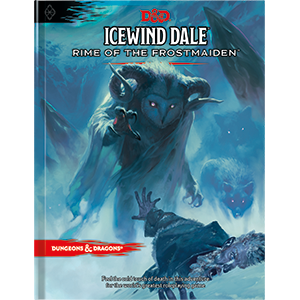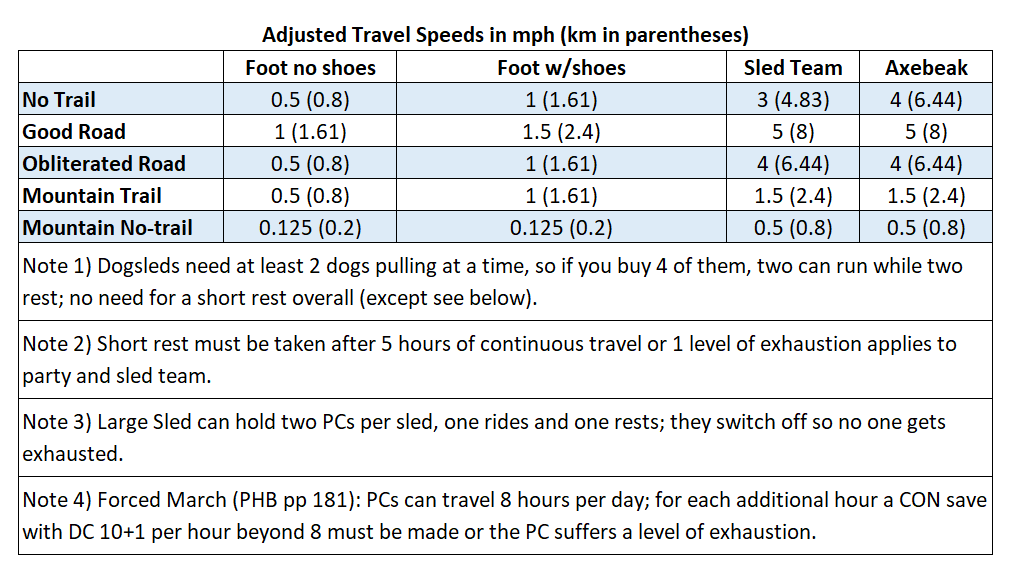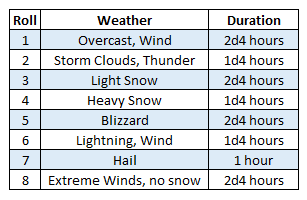**This post contains light spoilers – if you are playing Rime of the Frostmaiden, beware!***

I’ve now run 2 sessions of Rime of the Frostmaiden, with the next session coming this Friday. I also ran a session 0 to prep the players for the themes of the campaign. I thought it might be helpful to you, dear readers, if I write a bit about the changes I made and the information I used in these first sessions, and maybe where it is going next.
The Set Up
At the beginning of the first session I described the situation in Icewind Dale, which I had also done in session 0 but wanted to remind them. A few points to spotlight regarding the environment are rough travel conditions, extreme cold, and very poor lighting most of the time (with a nod to food scarcity). Let’s look at each of these individually and I will describe the changes I made and my rationale:
Travel Conditions. As the game begins, the PCs are on foot and do not have access to snowshoes. This means they are traveling slowly. I told them exactly how fast they can travel… 1 mile per hour on a good road. They were shocked at how slow, but I reminded them of the deep snow, ice, and occasional pools of water that might be found on or near even a well-maintained road after 2 solid years of winter. This pace is still faster than the pace in the book, which sets the speed at 1/4 mile per hour without snowshoes. I also increased travel time with snowshoes and the speed of dog sleds and axebeaks. In fact, I adjusted the entire movement table so that I can better accommodate the events in chapter 4. We’ll talk about that at a more appropriate time, but I will tell you that I increased the travel speeds in an effort to make the PC’s choices matter in chapters 3 and 4. Here’s the important point here though – the players don’t know that. All they know is how fast I am telling them their PCs can move. If they think it’s really slow, all the better because it underscores the difficulty with even basic activities in this environment. Here is the table I’m using with some notes that give you a sneak peak into my dogsled changes:

Extreme Cold. On page 11 of Icewind Dale: Rime of the Frostmaiden, we are told that the average temperature in the region is -49o F (-45o C). Windchill can take the temp even lower, by up to 80 degrees. The rules for extreme cold are in the Dungeon Master’s Guide (page 110) and are also written on page 11 of Rime. Basically they state that anyone exposed to the cold must succeed on a DC 10 Constitution save or gain one level of exhaustion. There are several ways to gain an auto success on this save, wearing cold weather gear being the most obvious and easily obtainable. In fact, I gave the PCs free cold weather gear in session 0 because, honestly, who would go to Icewind Dale and NOT have cold weather gear? None of my players had backgrounds or secrets that would put them in that position, so I didn’t force them to be without cold weather clothes.
So why am I bringing this up if I gave my PC’s the cold weather gear anyway? Because it feels reasonable to me that PCs would have cold weather gear, but irks me that something that should be so dangerous is so easily brushed aside. I know this is a fantasy world but in real life temperatures in the -40 to -80 range cause extreme changes in the body, even if the skin is not directly exposed. You will have a difficult time keeping your core body temperature up so your extremities will not get enough heat or oxygen, your muscles will not work as efficiently as you think they should, you will have to eat more to maintain your body mass, and your metabolism might slow down and cause you to move slower. Extreme weather clothing will protect against direct frostbite and cold burns, but it won’t stop the cold from affecting you.
I have a set of houserules that I implemented to add danger back into the extreme cold, even if the PCs have cold weather gear.
- Every 4 hours the PCs need to make a DC 10 Constitution save or start to feel numbness in their extremities, imposing disadvantage on attribute checks. This is not exhaustion and simply requires them to be indoors with a heat source for 1 hour to remove the penalty.
- The constant cold temperatures require each PC to eat twice as much as normal to retain enough body mass to keep their muscles and fat stores high enough to maintain their own body temperature. Failure to gather and consume enough food for two days in a row imposes 1 level of exhaustion on the PC. This also plays on the food scarcity theme I have going on.
- If a PC has a level of exhaustion or has failed their 4-hour save and is suffering numbness (from #1 above), and they are out in the wilderness without shelter for 24 hours, they suffer dire consequences – healing from spending hit dice is halved.
These problems and consequences are not insurmountable, but they do cause the PCs to think about travel and how long they spend outdoors. It’s important to note that I give Reghed tribesmen advantage on the Constitution saves against cold effects and anyone resistant or immune to cold never gains exhaustion from cold exposure.
Poor Lighting. This is perhaps the most underplayed aspect of the mini-setting that is Icewind Dale during the Rime. The entire setting never rises above a dim light amount of brightness and is dark more hours than it is dim. The available illumination from torches or even a light spell fares poorly in snowy and windy conditions – it’s almost like shining a bright light into a fogbank. But what effect does this have on the game? To find out, let’s look to the rules:

The 5th Edition Player’s Handbook states that areas in dim light count as lightly obscured and creatures have disadvantage on Wisdom (perception) checks that rely on sight (page 183). Full darkness in an area counts as heavily obscured and creatures suffer from the blinded condition (page 183). If we look at the conditions listed on page 290 we find that blinded creatures automatically fail checks requiring sight and attacks against the creature have advantage while their own attacks suffer disadvantage. Having darkvision only rescues this situation a tiny bit as creatures with darkvision can see in dim light without penalty and darkness as if it were dim light… BUT they cannot perceive color, only shades of grey. Now let me remind you that Icewind Dale is all ice and snow – it’s shades of white on dirty white layers with the occasional dark boulder or tree trunk here and there. Visibility is horrible almost 100% of the time in this game. I am not implementing any new houserules for this lighting situation, but I am doing my best to highlight to the players how poorly they can see every chance I get.
One last note about vision… The frequent blizzards, which cause whiteout conditions, also affect the visual acuity of the PCs. This is especially true if the party did not purchase goggles or other forms of eye protection. I do have a houserule for this, which I have not yet had a chance to implement: if the party gets caught in a blizzard and keeps traveling through it, each PC must make a DC 10 Constitution save or become temporarily snowblind for the duration of the blizzard plus 1d3-1 hours. Those with eye protection get to roll the save with advantage and on a failure only suffer blindness during the blizzard.
This all sounds very harsh. It is. This is a horror game with an environmental catastrophe occurring. You want to know why no one went to Icewind Dale to help the people? This is why – it is harsh and most people wouldn’t survive it.
Sidebar. Speaking of blizzards – it is important to know whether or not a blizzard is likely to occur. If your players are anything like mine, once they know that blizzards are so dangerous they will ask if they can predict the weather on any given day. Maybe they can and maybe they cannot, but it is a good idea to have something to look to, as the DM, to figure it out. Here is a simple weather table to help with that:

Roll 1d8 at the beginning of the day and determine the type of weather and the duration. Roll for the whole day at one time. If two of the same events are rolled consecutively, reroll the second one. This is a very simplistic table, but the idea is a simple one – the DM needs to have an idea of what the weather will be like during the adventuring day – not everything needs to be complicated.
Status Update: We have now finished sessions 0, 1, & 2 of my Rime campaign. If you want to watch session 1 and 2, they can be found here: Endless Night RotF session 1 and Endless Night RotF session 2.
You can support my work by checking out my latest DMsGuild release – it’s called The Creed of Auril and contains information on the Church of Auril and descriptions of cult beliefs, behaviors, membership, and rationale. It also has 16 new spells, 2 new magic items, 6 new NPC/creature statblocks, and over 12 detailed ways to add cultists and cult activity to the area. The product is $4.99 on the DMs Guild and you can purchase it by clicking here: The Creed of Auril
You can also support me and my co-creators by purchasing Scientific Secrets of Icewind Dale – new and challenging creatures and lore for your arctic D&D game: Scientific Secrets of Icewind Dale on the DMsGuild
Until next time, I wish you good gaming!
![]() ~DMSamuel
~DMSamuel

